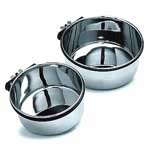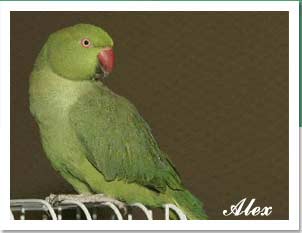Tips and Tricks:
Foraging for Health and Fun
by Chloe Redon and John GrazianoWe first tried foraging after our blue-crown conure started feather chewing. Our avian vet suggested we try foraging as a way to distract him from his tasty feathers. The foraging was quite successful in getting our obsessive little guy to stop feather chewing almost immediately. All of our birds now adore foraging. Here are some techniques we’d like to share.
Bowls
We use 5–ounce stainless steel coop cups with holders that bolt onto the cage. The advantage of the bolt-on cups is that, once the holder is secured, you can easily remove the cup without having to unclip a hanger or unscrew a bolt. We find them quite handy.
The 5–ounce cups are the perfect size for most small-to-medium-sized birds. Even larger birds can use them as long as they can get their beaks into the cup. For very large birds, the same cups are available in 10 ounce sizes and up.
We use four to six cups for a single bird and up to ten if a cage is shared.
The best price we have found for these cups is at Care-A-Lot-Pets.

- Food mix
- For the food part, we mix the following, but be creative with your own mix:
- 5 parts Harrison’s adult fine pellets
- 2 parts Harrison’s coarse pellets
- 3 parts “Just” dried foods (see below)
- 2 parts dried greens (see below)
- 1 part cinnamon sprouted cereal (see below)
You can get the “Just” dried foods at most higher-end grocery stores. We buy the organic versions when available, including peas, corn, peppers, carrots, crisp-dried raspberries and blueberries – and POMEGRANTES, don’t forget the pomegranates.
For the dried greens, we place any leftover fresh greens in a dehydrator overnight . We then crumble the dehydrated greens into the mix.
We use Lydia’s sprouted cinnamon cereal, which can be found in the “raw foods” section of most grocery or health-food stores.
Oh, and remember to add a few treats, like a real pistachio or pine nut in the shell – enough that every few cups gets one. You should hear my Pionus when he finds one of those, "Oh boy, oh … BO-O-OY!!"
Foraging Mix and Ratios
We combine the food mix with empty pistachio shells (see below) in a ratio of about 1 part food mix to 3 parts shells, so the birds have to pick through a lot of shells to find their food. For birds new to foraging, you might begin with only a few shells in the food mix. Or, you might try just the new dried foods, without shells.
To purchase the empty pistachio shells, you can order bags from "Polly Pajaro Treats"
NOTE: If you use that link 20% of your purchase will be donated to MCBR if you put "Mickaboo" into the "Special Notes" section when you check out your purchase. Details are described at that link.
Reusing, Cleaning and Sterilizing the Shells
We empty the bowls each night and start with fresh foraging in the morning. You can strain the pulverized food from leftover foraging and reuse the shells and whatever dried food remains. We store the leftover foraging mix in an air-tight container.
You can reuse the shells that fall onto the floor or cage bottom by boiling them in water, rinsing them well and then drying them in a 300-degree oven. A large chinese strainer is helpful in separating the shells from the smaller debris. Eventually, the shells will crumble and will need to be replaced
Advanced Foraging
For birds who “live to forage” we’ve made the experience more challenging by covering the bowls with wax paper. Many birds find this more fun than just the plain old shells with food mix. Our foster Jenday, Linus, has now advanced to several layers of wax paper and he couldn’t be happier. We have found that if your bird likes the wax paper covering, it tends to keep more of the mix inside the bowl and less of it flung all over the cage and floor.
In fact, our birds seem to prefer to fight through the wax paper and shells for their food, rather than have a food-only dish sitting right in front of them.
The paper also serves as a wedge to secure the bowl tightly in its holder. This is great for mischievous birds who like to dump the dishes more than they like eating their food.
In addition to foraging bowls, we also hang vegetable and fruit skewers, and traditional foraging toys.
Extra Tricks
Another way to keep your birds interested is to give them only enough foraging to last until late afternoon. That makes them excited to have dinner and even more interested in finding the last bits of food during the day. For dinner, our birds usually get chopped vegetables sprinkled with a little of the fine pellets or the sprouted cereal.
If you haven’t tried foraging with your birds, it’s a joy to watch. Birds seem to enjoy foraging every bit as much as playing with toys and grooming.
NOTE: All birds are different, so please do consult your veterinarian to ensure that your own feeding plan is right for your bird.

